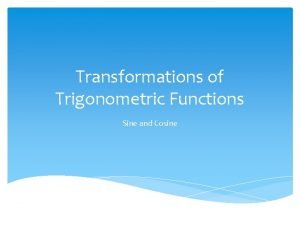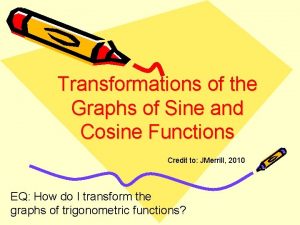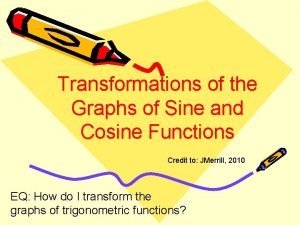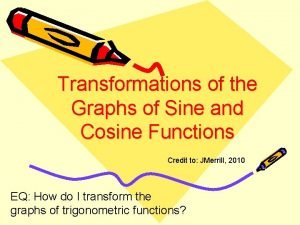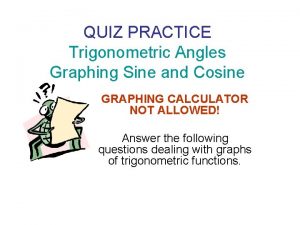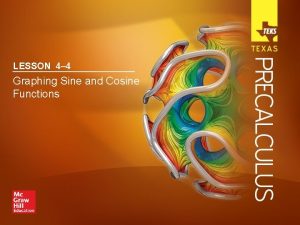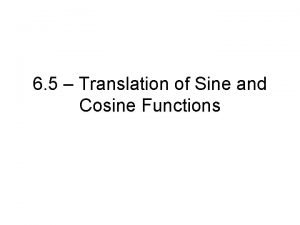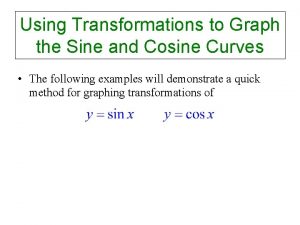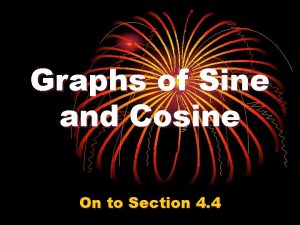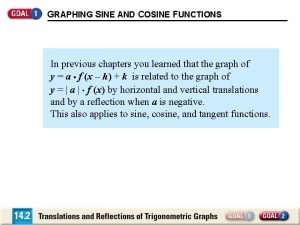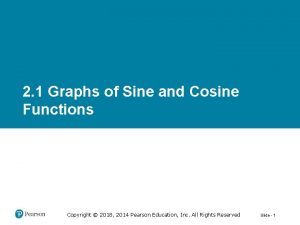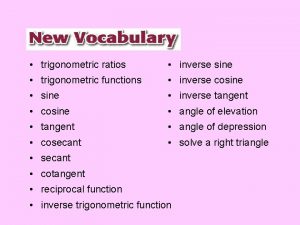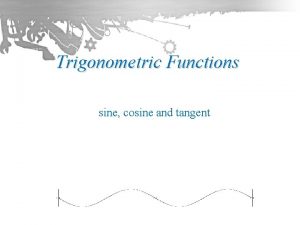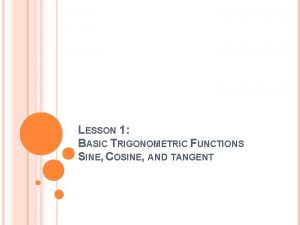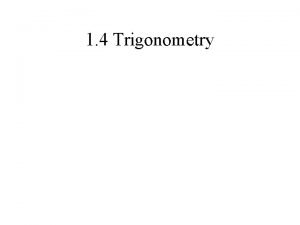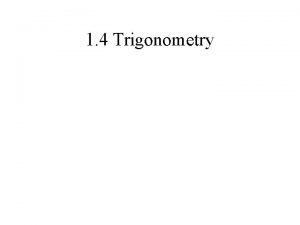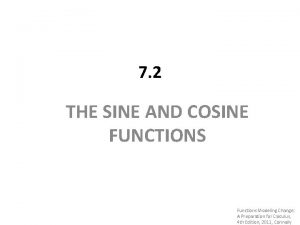Transformations of Trigonometric Functions Sine and Cosine Startup











- Slides: 11

Transformations of Trigonometric Functions Sine and Cosine

Startup Accessing Background Knowledge Work with your partner to answer the question written on the board; AT LEAST 3 POINTS Find someone wearing the same color shirt as you. Trade ideas, and add to your list. ADD AT LEAST 2 POINTS that you didn’t already have. Form into groups of 4. Add to your lists, and be ready to share 1 thing with the class that you remember.

Gather Your Supplies 1 yardstick 1 wax paper strip 1 poster marker 1 Sharpie marker 2 pieces of tape Your paper plate and ½ sheet of graphs (optional) Return to your seats

Round 1: Graph the parent function (Text to graph) On the poster, graph a well-labeled, accurate set of axes for graphing trig functions Graph your assigned parent function, written on the poster paper Make the distance from 0 to 1 on the y-axis to be about 5 inches. Mark at least 5 “important” points on the graph (i. e. maxima, minima, zeros, etc. ) Using tape, hang the strip of wax paper over your function; trace the parent function onto the wax paper, including the 5 important points Return to your seats

Round 2: Inference about “h” (Text to graph) Background knowledge: Tell your partner what you remember about the role of “h” in the equation y = a(x-h)2 + k Make an inference about what “h” will do in a trig function Move 1 poster to the right. Check the work of the previous pair, and discuss any questions with them Take card “h” off the wall. Look at the transformation of the parent function, and move the wax paper as indicated by “h”. Hang the wax paper in its new spot, and hang “h” back on the wall face-up. Return to your seats

Round 3: Inference about “k” (Text to graph) Background knowledge: Tell your partner what you remember about the role of “k” in the equation y = a(x-h)2 + k Make an inference about what “k” will do in a trig function Move 1 poster to the right. Check the work of the previous pair, and discuss any questions with them. Take card “k” off the wall. Look at the transformation of the parent function, and move the wax paper as indicated by “k”. Hang the wax paper in its new spot, and hang “k” back on the wall face-up. Return to your seats

Round 4: Inference about “a” (Text to graph) Background knowledge: Tell your partner what you remember about the role of “a” in the equation y = a(x-h)2 + k Make an inference about what “a” will do in a trig function Move 1 poster to the right. Check the work of the previous pair, and discuss any questions with them. Take card “a” off the wall. Look at the transformation of the parent function. This time, draw your transformed function directly onto the poster using a DIFFERENT COLOR than the parent function. Throw away your wax paper. Place cards “h”, “k”, and “a” into the correct bins on the desk. Return to your seats

Round 5: Graph to Text Rotate 1 poster to the right. Check the work; discuss any questions with the previous pair. Using the equation of the parent function with the graph of the transformed function, write the equation of the transformed function onto the poster paper. Return all materials. Return to your seats.

With Your Partner. . . . Sketch the graph of the function f(x) = 2 sin (θ - π) - 1

With your partner…. . Where on the x-axis would the zeros be for the equation… f(x) = cos (θ - π) + 1 f(x) = tan (θ + π) – 1 f(x) = sin (θ – π/2)

Exit Slip Hand in your exit slip as you leave class. NO NEW HOMEWORK tonight…make sure you’ve finished all previous homework. Mrs. Lee will teach class tomorrow. I expect to receive another EXCELLENT report!
 Sine cosine partner
Sine cosine partner Transformations of sine and cosine functions
Transformations of sine and cosine functions Normal sin graph
Normal sin graph Graph sine and cosine functions
Graph sine and cosine functions Graphing sine and cosine quiz
Graphing sine and cosine quiz 4-4 graphing sine and cosine functions
4-4 graphing sine and cosine functions Sinusoidal equation
Sinusoidal equation Horizontal phase shift
Horizontal phase shift Sine and cosine graphs
Sine and cosine graphs Graph of sine and cosine functions
Graph of sine and cosine functions Horizontal shift
Horizontal shift Graph of sine and cosine functions
Graph of sine and cosine functions
